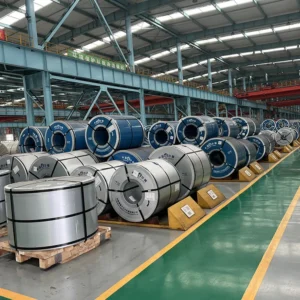Electrical Steel: Enhancing Efficiency and Performance in Modern Power Systems
In an era defined by energy transition, electrification, and the rise of smart infrastructure, the importance of materials that improve efficiency and reliability cannot be overstated. One such material—electrical steel—forms the magnetic backbone of modern power systems. From transformers and motors to renewable energy systems and EV infrastructure, electrical steel supports the low-loss transmission and conversion of electrical energy.
This article explores the critical role of electrical steel in today’s global energy landscape, with a focus on its properties, manufacturing process, applications, market trends, and innovations. The content is particularly relevant to professionals and organizations in Europe and the Middle East, where demand for high-performance, low-emission infrastructure is accelerating.
What Is Electrical Steel?
Electrical steel, also known as silicon steel or lamination steel, is a specialized magnetic material used in the cores of transformers, motors, generators, and other electromagnetic devices. Its key characteristic is its ability to conduct magnetic flux with minimal energy loss, making it essential for efficient electrical energy conversion.
There are two main types of electrical steel:
- Grain-Oriented Electrical Steel (GOES):
Optimized for unidirectional magnetic flux, primarily used in transformers. - Non-Grain-Oriented Electrical Steel (NGOES):
Suitable for rotating machines such as motors and generators where the magnetic field direction changes constantly.
The performance of these steels depends on their chemical composition, grain structure, and insulation coating, all of which are engineered for specific applications.
Properties of Electrical Steel
Electrical steel is valued for its highly specialized properties, which allow it to reduce energy losses in electromagnetic systems:
- Low Core Loss:
Minimizes the heat generated during magnetization cycles, improving energy efficiency. - High Magnetic Permeability:
Facilitates the easy passage of magnetic fields, requiring less energy to magnetize. - Low Coercivity:
Ensures low resistance to changes in magnetic direction, crucial for alternating current (AC) systems. - Excellent Surface Insulation:
Reduces eddy current loss when the steel is laminated and stacked. - Thermal and Mechanical Stability:
Performs reliably under heat and electromagnetic stress, ensuring long equipment life.
These characteristics make electrical steel the material of choice for engineers focused on high-efficiency power devices.
Manufacturing Process of Electrical Steel
The production of electrical steel is a multi-step process that ensures precise magnetic properties and surface characteristics:
- Steelmaking and Alloying:
Silicon is added (usually 1.5–3.5%) to improve resistivity and reduce core loss. - Hot Rolling:
Slabs are rolled into intermediate gauge to start forming the grain structure. - Cold Rolling:
Reduces thickness while refining surface quality and grain orientation. - Annealing:
Relieves stress and prepares the grain structure for further processing. - Decarburization and Secondary Recrystallization:
For GOES, the steel is heat-treated to achieve the ideal Goss texture ({110}<001>) for directional magnetic performance. - Insulation Coating Application:
A non-conductive layer is applied to prevent inter-laminar currents in core stacks. - Domain Refinement (Optional):
Techniques like laser scribing are used to refine magnetic domains and lower loss even further.
Quality control is stringent at every step, with advanced inspection systems ensuring product uniformity and adherence to electrical standards.
Key Applications of Electrical Steel
Electrical steel is indispensable in the manufacture of:
1. Power and Distribution Transformers
Transformers convert voltage levels to make electricity transmission and distribution more efficient. Electrical steel cores reduce no-load losses and improve thermal performance.
2. Electric Motors
Used in HVAC systems, industrial drives, electric vehicles, and appliances. NGO electrical steel ensures better torque, speed control, and energy savings.
3. Generators
In both fossil-fuel and renewable power stations, generators rely on electrical steel for efficient power conversion.
4. Renewable Energy Equipment
Wind turbine generators, solar inverters, and battery management systems use electrical steel to minimize heat and maximize output.
5. Smart Grid Components
Devices like voltage regulators, inductors, and reactors also use electrical steel to improve grid responsiveness and efficiency.
In both developed and emerging energy economies, the role of electrical steel in achieving sustainability and reliability targets is only growing.
Market Trends in Europe and the Middle East
Europe
Europe is accelerating its transition to low-carbon, electrified energy systems. Electrical steel is central to this evolution:
- Green Grid Upgrades:
Aging grid components are being replaced with high-efficiency transformers and motors. - Electric Mobility:
EU directives are fueling demand for NGOES in electric vehicles and charging infrastructure. - Energy Efficiency Regulations:
EN 50588 and Ecodesign requirements are pushing utilities to adopt equipment made with high-grade electrical steel.
Middle East
The Middle East is rapidly expanding its electrical infrastructure, both in conventional energy and renewables:
- Mega Projects:
Smart cities like NEOM, Expo-related infrastructure, and high-speed transit systems depend on advanced electrical steel-based components. - Solar and Wind Integration:
Regional diversification strategies are increasing the need for efficient transformers and grid stabilization equipment. - High-Temperature Environments:
Electrical steel performs reliably in harsh climates, making it ideal for use in desert conditions.
Innovations in Electrical Steel Technology
The electrical steel industry continues to push performance boundaries through innovation:
- Ultra-Thin Laminations:
New grades allow for lighter, smaller transformers and motors with reduced loss. - Hi-B and Super Hi-B Grades:
Provide extremely low core loss and are used in energy-intensive grid applications. - Eco-Friendly Coatings:
Water-based or chromium-free coatings improve insulation without environmental risk. - Digital Process Control:
AI and real-time monitoring optimize rolling and annealing processes for consistent grain orientation.
These advancements make electrical steel more adaptable to the energy demands of the future—both in traditional utilities and smart, decentralized power systems.
Environmental Benefits and Sustainability
Electrical steel supports environmental and ESG goals in several key ways:
- Reduces Energy Consumption:
By minimizing core losses, it helps lower overall electricity demand. - Supports Electrification:
Enables cleaner transport, heating, and industrial processes. - Recyclability:
Steel is fully recyclable with no degradation in magnetic performance. - Low Carbon Footprint:
Modern steel mills are using renewable energy and carbon-neutral production technologies.
Governments and corporations alike see electrical steel as an essential tool for building greener infrastructure.
Conclusion
Electrical steel is not just a raw material—it is a strategic enabler of global energy transformation. With its unmatched combination of magnetic efficiency, durability, and adaptability, electrical steel is at the core of devices that power homes, factories, cities, and entire nations.
As Europe invests in digital and sustainable grid technology, and the Middle East scales up smart infrastructure and renewable generation, the demand for electrical steel will only continue to rise. The steel’s role in achieving energy efficiency, grid reliability, and environmental compliance makes it a foundational material for a cleaner, electrified future.




